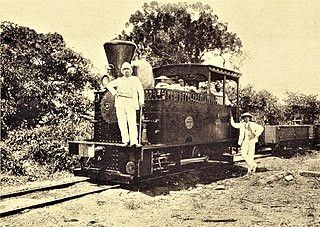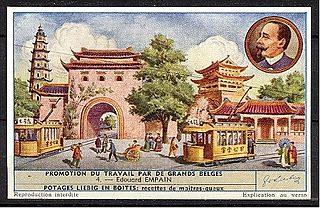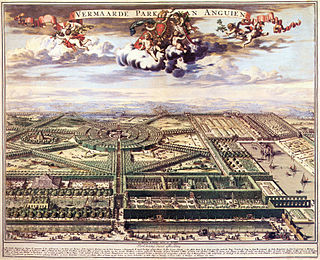
The second Battle of Nördlingen was fought on August 3, 1645 southeast of Nördlingen near the village of Alerheim. France and its Protestant German allies defeated the forces of the Holy Roman Empire and its Bavarian ally.

Enghien is a city and municipality of Wallonia located in the province of Hainaut, Belgium.

Montmorency is a commune in the Val-d'Oise department, in the northern suburbs of Paris, France. It is located 15.3 km (9.5 mi) from the center of Paris.

Heliopolis was an early 20th century suburb outside Cairo, Egypt, which has since merged with Cairo and is administratively divided into the districts of Masr El Gedida and El Nozha in the Eastern Area.
Château d'Armailhac, previously named Château Mouton-d'Armailhacq, Château Mouton-Baron Philippe, Mouton Baronne and Château Mouton-Baronne-Philippe (1979–1988), is a winery in the Pauillac appellation of the Bordeaux region of France. The wine produced here was classified as one of eighteen Cinquièmes Crus in the Bordeaux Wine Official Classification of 1855. In 1989, Baroness Philippine decided to restore its original identity to Mouton d’Armailhacq, giving it the name Château d’Armailhac.

The Château d'Oricourt is a castle in the commune of Oricourt in the department of Haute-Saône, in the Franche-Comté region of France.

The Château of Modave, also known as the Château des Comtes de Marchin is a château near the village of Modave in Liège Province, Wallonia, Belgium.

The Château of Seneffe or Château de Seneffe is an 18th-century château located in the municipality of Seneffe in the province of Hainaut, Wallonia, Belgium. The château is property of the French Community of Belgium and serves as the "Centre de l'orfèvrerie de la communauté française" which displays a collection of antique silverware.

Bathilde d'Orléans was a French princess of the blood of the House of Orléans. She was sister of Philippe Égalité, the mother of the Duke of Enghien and aunt of Louis Philippe I, King of the French. Married to the young Duke of Enghien, a distant cousin, she was known as the Duchess of Bourbon following the birth of her son. She was known as Citoyenne Vérité during the French Revolution.

The present chapel of the Palace of Versailles is the fifth in the history of the palace. These chapels evolved with the expansion of the château and formed the focal point of the daily life of the court during the Ancien Régime.

The Castle of Thy-le-Chateau is a medieval castle located in Thy-le-Château, Walcourt in the Province of Namur in Belgium. Originally built in the 12th century, it served as the military fortress for several noble clans until the French Revolution, when it fell into disrepair. The castle was successfully restored in 1939.
Morialmé Castle is a château in Morialmé, part of the municipality of Florennes, province of Namur, Wallonia, Belgium.

The Villa Empain is a former private residence in Brussels, Belgium, which currently serves as a cultural centre and exhibition space. Built in 1930–1934 in Art Deco style by the Swiss-Belgian architect Michel Polak, the villa was commissioned by Baron Louis Empain, son of the industrialist Édouard Empain. It subsequently served as offices and an embassy before falling into disuse. After a restoration from 2009 to 2011, it was opened to the public by the Boghossian Foundation.

The Baron Empain Palace, also known as Le Palais Hindou, is a distinctive and historic mansion in Heliopolis, a suburb northeast of central Cairo, Egypt. It was built in 1905 for Édouard Empain, Baron Empain, a Belgian businessman and industrialist with particular interests in tramways. The building was inspired architecturally by Hindu temple.

The Château d'Enghien in Chantilly, France is a building within the park of the Château de Chantilly.

Sanem Castle, located in the village of Sanem near Esch-sur-Alzette in south-western Luxembourg has a history dating back to the 13th century. Today's building was completed in 1557 after the medieval castle had been partly destroyed. The castle still maintains much of its original character.
The Château de La Falize was built in the 15th and 16th centuries with 20th century additions. It is located about 5 kilometres (3.1 mi) north of the city centre of Namur just off the old Gembloux-Namur at the top of the steep northern valley slope of the river Meuse. It is in the province of Namur in Wallonia.

The Compagnie du chemin de fer du Congo supérieur aux Grands Lacs africains was a Belgian railway company established in 1902 in the Congo Free State, later the Belgian Congo, now the Democratic Republic of the Congo. It provided service in the eastern part of the colony south of Stanleyville (Kisangani) to serve the settlers and mining operations in Katanga. It operated a combination of river steamer service along the Lualaba River and railway links where the river was not navigable, including a link to Lake Tanganyika. In 1960 it became the Société congolaise des chemins de fer des Grands Lacs.

The Empain group was a loose grouping of companies founded by Édouard Empain (1852–1929) of Belgium and controlled by the Empain family. From 1881 until merging with Schneider & Cie in 1969, the companies engaged in a broad range of activities including tramways, railways, electricity generation, construction and mining. The main areas of activity were Belgium and France, but the group also pursued opportunities in Russia, Egypt, China and elsewhere, and played a large role in the development of the eastern Belgian Congo.

The Enghien Gardens are a domain of 182 hectares in Enghien or 'Edingen', Wallonia, Belgium, created by the dukes of Arenberg in the 17th and 18th century. The park is a green oasis of ponds, gardens and follies. Many considered the gardens a wonder of the world. Nothing remains of the Arenberg castle other than the chapel tower. Within the park, a new château was created in the 20th century. The Enghien municipality acquired the gardens in 1986, and opened them to the public.
















